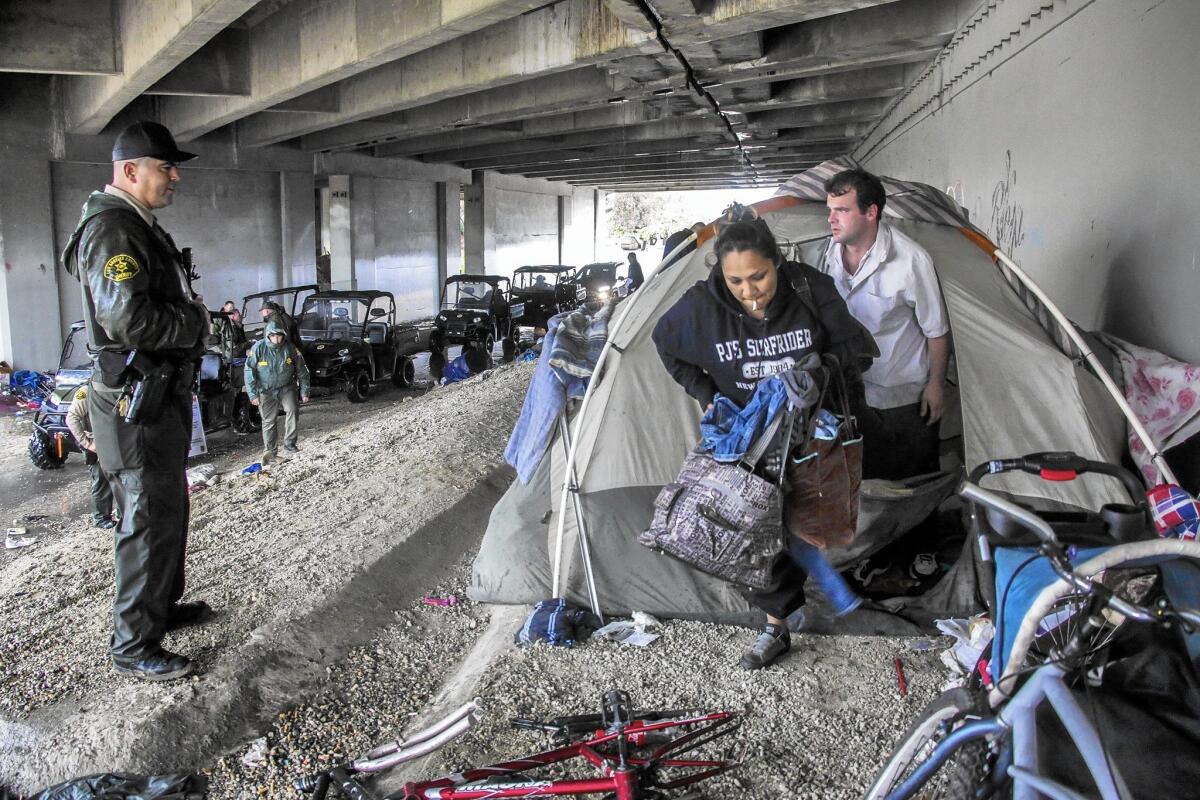New cost estimates for homeless plan put L.A. officials on the spot

Los Angeles has struggled for decades to conquer homelessness, only to see the problem grow worse in recent years as tent-and-tarpaulin shantytowns have taken root in neighborhoods from Venice to Boyle Heights.
Elected city officials have said that solving nation’s worst homelessness crisis is among their top priorities, but they have devoted comparatively little money toward housing and services, including $30 million this fiscal year.
On Thursday they were presented with a much larger tab for getting 26,000 men, women and children into homes: at least $1.85 billion over the next 10 years, according to long-awaited recommendations from the city’s top budget analysts.
Join the conversation on Facebook >>
The report — prepared by City Administrative Officer Miguel Santana and Chief Legislative Analyst Sharon Tso — comes after months of collaboration between the city and county to craft the region’s first comprehensive plan for curbing homelessness in more than a decade.
The report’s principal — and most expensive — suggestion is the expansion of long-term housing for the homeless.
It concludes that homelessness in L.A. is in part “the result of underfunding and under-building affordable housing over an extended period of time, while failing to build adequate capacity to serve and house existing homeless Angelenos.”
The analysts suggest improving the city’s short-term shelter options and creating a centralized case-management system for the homeless.
The report offers dozens of options for raising the money needed to carry out this plan, such as state and federal grants and the use of fees on real estate transactions and development. For such a large sum, however, the report noted that city voters may also have to approve a bond or tax increase.
The analysts’ recommendations could reverberate powerfully at City Hall. With its premise that homelessness can be reduced only through long-term government spending on housing and social services, the report places the responsibility for one of L.A.’s most recognizable social ills squarely on the city’s political class.
The city’s report appeared on the same day as a county blueprint for spending $150 million in the near term on its own homelessness strategies.
The budgetary implications for the county are not as stark, however, since county officials already have ongoing sources of funding for addressing homelessness. The county plan also did not identify an overall dollar figure needed to address homelessness, as the city plan did.
In relying heavily on permanent housing coupled with medical and social services and expanded outreach, the city and county reports largely hewed to practices espoused by homeless advocates across the country.
But Santana and Tso were unusually frank in acknowledging that only a massive expenditure of public funds, perhaps needing the approval of city voters, would suffice to underwrite that vision.
“While costs to fully address homelessness are significant, the cost of inaction will continue to grow,” the report states.
The report also notes that the estimated $1.85 billion the city must spend to combat homelessness includes primarily the price of building or leasing new housing units — not the cost of many supportive services for the homeless or for expanding the city’s system of outreach workers, as the report also recommends.
It is unclear how warmly the report’s strategies and and spending recommendations will be received by the council and Mayor Eric Garcetti.
In a statement, Garcetti said the report “gives us the blueprint we need to guide our decision-making process, and its recommendations will help us allocate the critical funding we need to address this issue over the next decade.”
Council President Herb Wesson said in a statement that the council “rolled up its sleeves and crafted a strategic plan that not only creates a blueprint for Los Angeles, but also complements the county and state’s efforts.”
Councilman Mike Bonin, whose Westside district has seen one of the sharpest increases in homeless encampments, suggested that he supported the long-term approach recommended in the report but would like to see it coupled with more immediate action.
“I am grateful, encouraged and tremendously impatient,” Bonin said in a statement, adding that the city needs “… immediate action that will reduce the number of encampments in our neighborhoods and get people living on our streets the support and services they need and deserve.”
Elected officials did not address the report’s details.
Should city officials choose to follow the report’s recommendations, they could potentially lean on either the state or federal government for financial help.
Earlier this week, state senators proposed spending $2 billion to build or rehabilitate permanent housing for mentally ill homeless people across California.
In the last year, council members have been repeatedly castigated for inaction as homeless encampments continue to spread.
The reports come at a time when the risks to L.A.’s homeless have been aggravated by El Niño storms that bore down on Southern California this week.
Last fall, the council set aside $12.4 million for emergency relief, especially for those who live in areas prone to flooding.
Teams were sent to warn more than 1,000 people living in watersheds and riverbeds to move to winter shelters or at least high ground.
Naomi Goldman, a spokeswoman for the city-county Los Angeles Homeless Services Authority, said that as many as 700 homeless people remained in dangerous areas along the Los Angeles River as the brunt of the first big storm hit Monday.
In its separate report, the county proposed launching 12 initiatives now, and studying others.
The priorities set for this year include spending $26million to rapidly re-house families that fall into homelessness; allocating 35% of federal housing vouchers that become available to people who are chronically homeless; and giving $11 million for short-term housing such as shelters and group homes for people coming out of county institutions such as jails and hospitals.
County Supervisor Sheila Kuehl said the county, which has a $28-billion annual budget, has more resources than the city to put toward addressing homelessness and will have to make a larger commitment in the long term.
“The county is going to be called on to do the heavy lifting, and I think we are making an unprecedented commitment to do that,” she said.
Times staff writer Emily Alpert Reyes contributed to this report.
Twitter: @petejamison
Twitter: @geholland
Twitter: @sewella
ALSO
Iraqi refugee arrested in Sacramento on suspicion of lying about terrorism ties
Gov. Jerry Brown’s budget helps schools and the poor -- and saves a lot for a rainy day
Monster waves batter California coast as latest El Niño storm passes through
More to Read
Sign up for Essential California
The most important California stories and recommendations in your inbox every morning.
You may occasionally receive promotional content from the Los Angeles Times.













